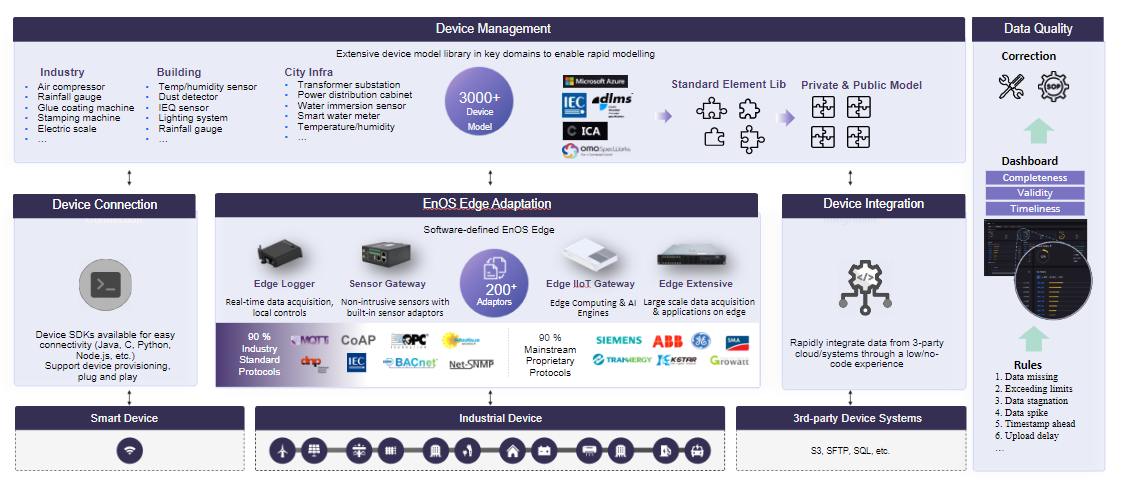EnOS Device Connectivity and Management¶
EnOS Device Connectivity and Management helps you quickly and securely connect physical devices to EnOS and start to transfer data, manage device lifecycle, and map the physical asset structure to the digital world. The capabilities of EnOS Device Connectivity and Management on EnOS include device modelling, device connectivity, device management, and device data quality.

Device Modelling¶
Modelling in EnOS allows assets of similar characteristics to be unified into a general model to facilitate data analytics and application processing. A model is the abstraction and digitization of the physical objects, both device and logical assets, in the physical world. It describes the characteristics of the object, its capabilities, and the services it can provide.
EnOS supports the reuse and standardization of models with the public model library and supports the standardization of features across models, the building of a consistent and standard data scheme, and driving the reuse of different models and applications with the standard model feature library by providing model features based on industry standards such as IEC, ICA, and OMA. Assets need to be modelled first before they can connect to EnOS.
Device Connectivity / Device Data Onboarding¶
The first thing to do on an IoT platform is to connect your devices to transmit data. In EnOS, there are three main approaches to onboard your device data: through direct connection from device to EnOS Cloud, connection through a gateway to EnOS Cloud, or through cloud-to-cloud integration. You can choose the method based on several factors such as the device data format, the connection protocols used by the device, and the device type.
Direct Connection¶
Smart devices can connect to and communicate with EnOS directly through 3 device protocols, namely MQTT, HTTP, or CoAP, via Wi-Fi, GPRS, 3G, or 4G signals. Such devices include devices with smart acquisition rods, such as household inverters, and household energy storage batteries and smart home devices, such as surveillance cameras, and smart thermometers and hygrometers.
Connection Through Gateway¶
Another way to connect devices to EnOS is through an edge gateway device. After a device is connected to the gateway, the gateway device communicates with EnOS based on the MQTT protocol. The device data are first collected by the edge gateway where the gateway serves as a proxy to help the devices complete operations such as login and data transmission. The device types that can connect to EnOS via this method include both smart devices and non-smart devices. Non-smart devices lack the ability to connect to EnOS via Wi-Fi, 3G, or 4G.
Cloud-to-cloud¶
Certain devices might have already been onboarded or provisioned in an existing system or cloud, in this case, you can use EnOS Device Integration Service to design and build integration flows in a low code or no code manner to integrate device data across enterprises or organizations
Device Management¶
EnOS provides a full device lifecycle management as per your business needs, from the planning and design phase to the provisioning phase, servicing phase, maintenance phase, and finally the decommissioning phase.
Device Data Quality¶
EnOS Device Data Quality monitors the quality of real-time data accessed from EnOS Device Connectivity & Management for completeness, validity, and timeliness based on configurable assessment rules and generates quality dashboards and reports to help enterprises easily assess data quality.